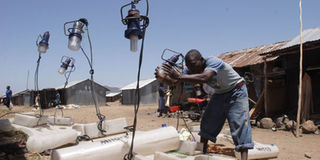A bright cheap way to catch ‘omena’

A fisherman in Nyachebe Beach in Mbita prepares his solar charged energy hubs introduced by a German company Osram to replace kerosene lantern used for catching omena. Photo/TOM OTIENO
Two years ago, Victor Oduor Abonyo used to make Sh3,000 from his omena fishing business in a day.
Today, on a good day, he takes home Sh12,000 from the single boat he owns at the Nyachebe Beach in Suba District.
Abonyo is among fishermen in Mbita, Sindo and Nyandiwa whose business have prospered due to a German company’s investment in a cheaper source of light for fishing.
“Fishing omena (sardines) is now easy, lucrative and less expensive. The technology has transformed our lives,” said Abonyo.
Before the Osram energy hub came, fishermen used kerosene lanterns to attract sardines.
The German-designed Osram energy hub or plastic float is a solar charged lantern fitted onto a floater made of recycled plastic and used by fishermen to attract sardines at night.
The old kerosene alternative was expensive and inconvenient during foul weather.
During a tour of the Osram firm in Mbita town, company senior vice president Wolfgang Gregor said: “We conceptualised German technology to suit the local people using locally assembled materials.”
The energy hub is made of a plastic floater at the base, fitted with a one meter metal pipe which holds the rechargeable lantern at the top.
At the centre, a full set box is fitted used to store energy for the lantern and is the control unit. The floaters have spaces to tie stones which act as anchors to stop it from moving from side to side.
“This makes it possible for fishermen to place it at a strategic place without worrying about it being swept away or get extinguished by wind,” said Gregor.
Elijah Omolo, the chairman of Nyachebe Beach Management Unit says: “We used lanterns at night to attract sardines. These are fish that will swim towards light, getting caught in the net. But the lanterns used a lot of kerosene and could go off on a windy night.”
One boat needed between five to eight lanterns positioned at different points depending on how wide the fishing net was.
“Buying kerosene for the five lanterns was expensive, considering the number of hours fishermen spend on the lake catching the fish,” said Elijah.
The lantern’s glass could also break and the kerosene’s smell drove away sardines reducing the catch. The lanterns were floated in water using reeds and sometime strong winds and a current tipped them over.
But with the Osram energy hub, fishermen need only Sh25 to recharge the lanterns each day. “The light is also very bright and attracts more omena. With the new technology, you can leave the lanterns and return after sometime when enough omena have been trapped,” said Omolo.
Osram company has made the lanterns affordable and easily available. “When we started three years ago, some fishermen believed in their traditional methods and thought we had a hidden agenda,” said Daniel Opiyo, Osram’s operations manager.
Opiyo said they do not sell the Osram energy hubs to the fishermen, but lease them out and charge additional costs for recharging. The plastic floater and the lantern is leased at Sh1,000 while the control box is leased for Sh500. Recharging costs Sh25 a day.
“When fully charged, the lantern can last for eight hours. This means using Sh25 instead of over Sh100 they used for kerosene,” said Opiyo.
The company repairs the lanterns free. “The fishermen use them at home when they don’t go fishing. It is a double benefit,” said Opiyo.
German ambassador
On Monday, German ambassador to Kenya Margit Hellwig-Boette said: “This is one of the projects we put up to help alleviate poverty among the fishing community.” The envoy said her country released $4.5 million to the project.
Osram warehouse is in Mbita town and has four rooms — one is for displaying finished products; one is an office, another room is for receiving lanterns brought for recharging while the last room is for recharging.
On the roof are solar panels used to recharge. The surplus energy is used to charge mobile phones.
“This is a profit making company and after we do a good market study to establish how many lanterns will be required in major fishing beaches, we will recover all costs,” said Gregor.
One fisherman can lease between 15-30 Osram energy hubs. So far, they have supplied 62 fishermen with over 300 energy saving lanterns.




